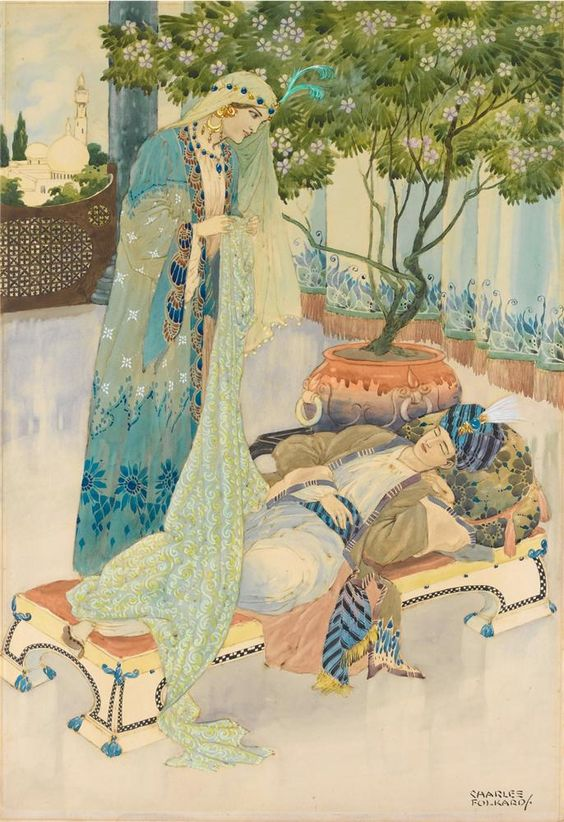(painting by Charles Foulkard)
Can you imagine a Cinderella who has long talks with the prince about whether to invite her step-mother to the wedding? Can you even name Snow White’s prince? Of course not because those men are not princes, they aren’t even men, they are place-markers. You never see life AFTER the wedding because the ‘wedding’ is a metaphor for a smart, strong woman solving her problem. Like so much in life, Darling, it’s all metaphors!
Aurora’s “kiss” in Sleeping Beauty is not a kiss – it’s AA which helps you wake up from the haze of alcoholism.
“Wolf” in Little Red Riding Hood is not a wolf – it’s your sexist boss, your conniving coworker, that teacher who never believed in you, your too aggressive coach, that relative who makes fun of you.
The “dwarves” in Snow White are all the people who help you who (at first) you do not recognize as strong, smart, brave and loyal.
And what looks like a weakness is a strength that you must acknowledge and cherish. Monica Hesse, so wise, writes in response to the movie Snow White and the Huntsman:
Because Snow White’s defining characteristics are her kindness and compassion to animals (just as Cinderella’s was her work ethic, and Red Riding Hood’s was her sense of familial duty), then why not have her use those strengths to defeat the queen? Why not have her rally a flock of birds to dive-bomb the magic mirror room? There are ways to update fairy tales that don’t lose the integrity of the original character. But when Kristen Stewart spends the first half of “Snow White” charming woodland creatures and then spends the second half slipping into chain mail for a hero’s run, that’s not creating a more three-dimensional Snow White. That’s replacing Snow White mid-movie with Katniss Everdeen.
Pay attention, Darling.
The “Princess and the Pea” teaches you to take care of your own comfort. She’s not overly picky; she believes that her comfort is important so take heed and THROW OUT with that sofa you hate sitting on or those fashionable shoes which hurt your feet. (And beware over-involved mothers-in-law!)
Belle explains about how people dive into books to escape overly self-involved family members but that this is not an effective strategy because overly self-involved family members will figure out ways (by “accident”) to make YOU pay for their sins. And trust people who have nice libraries.
Rapunzel gives you the lesson that having a special talent can trap you, box you in and make you prey to other people’s wishes. Also, don’t spend too much time on your beauty routine.
Jasmine shows you that you need to wait for a romantic partner who transports you (magic carpet, van conversion, Vespa, old Land Rover…). And befriend wild animals.
Ariel explicates how getting what you want requires sacrifice, especially leaving your family behind. Her prince is the equivalent of studying overseas.
Tiana illuminates the moral that you should never trust men to take care of everything and if you try to rescue someone, you can end up in trouble.
Odette has a similar lesson – men will profess undying love and then run off with someone who looks vaguely like you.
More recent princesses are more clear about their power even while in love: Fiona in Shrek and Buttercup pushing the Dread Pirate Roberts down the hill. Some have dispensed with the prince metaphor entirely (Moana, Elsa, Merida and Mulan) or the prince is (finally!) a negative character as with Anna in Frozen.
Of course you need a side-kick (alien, chameleon, candlestick, crab, firefly, raccoon, rooster, seagull or tiger) but there is no need for a prince.
So go forth and conquer.
1001 Reasons to Behave: The Etiquette-Fairy Tale Connection
https://www.wattpad.com/1259394686-yusef-the-thief-and-mubarak-the-cook-from-tales



You must be logged in to post a comment.